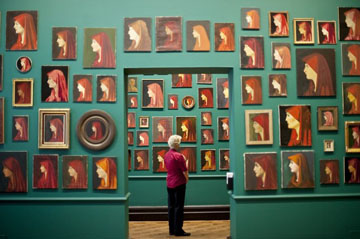
Francis Alys, "Fabiola," at the National Portrait Gallery (BEN STANSALL/AFP/Getty Images)
You go into a room full of paintings and every single one is identical, floor to ceiling. They’re packed in about an inch apart, each no more than the size of a record sleeve, some much smaller. Each one is a profile portrait of a woman’s head and shoulders looking to her left against a dark background and in each one she wears a hood that reveals enough of her face to show a distant, slightly upturned eye and a set jaw beneath a tiny cloud of brown hair. They’re not identical though, you notice. One flattens out the woman’s cheek and neck to a jagged slab; another splits the image into shards; another renders the saint in dried beans. A couple paint the hood green; most are deep red. Each work is by a different unnamed artist, all of whose work is collated in Francis Alÿs’s installation Fabiola, now at the National Portrait Gallery, and all 300 of them depict the same woman, the eponymous Roman saint who died over 1600 years ago.
Because of that out-of-shot gaze, the head turned away from you, each painting has an unsettling effect; looking is like trying to get someone’s attention behind a pane of soundproof glass. Piled up as the paintings are, nudged in around the doorjamb and over the frame of the doorway, that indifference accumulates, and you get the feeling very early on that this accumulation could go on forever, an endless deferral of attention. Look closer. Each image bears the idiosyncrasies of its provenance. Some hung in living rooms among potted plants and lampshades; others were the focus of domestic shrines, bookended by candles. Many have spidery cracks along their edges, bearing the stigmata of use. Some are sun-bleached. It’s alarming to be in the midst of works of art that have received such intense focus; it’s like a corrective to ordinary looking, a reminder of the narrowness of contemporary ideas of what art is for and what it can do.
In line with much of Alÿs‘s output, Fabiola is the product of collective endeavor. In 2002, he harnessed a team of 500 volunteers to move, shovel by shovel, a huge sand dune on the outskirts of Lima, in a piece entitled When Faith Moves Mountains. In Fabiola, faith is similarly parsed as a mobilization of minds in simultaneous concentration. Here, though, the effort is dispersed yet coherent. Alÿs came to collect the images partly by chance. Planning to garner a collection of amateur knock-offs of old master paintings, he discovered a surfeit of works depicting the same woman, all apparently deriving from the same source. That source emerged as Jean-Jacques Henner’s now lost portrait of the saint (here the works take on an ekphrastic quality that lends the collection a quixotic melancholy), probably produced in response to the publication of Fabiola’s best-selling biography in the mid-nineteenth century. Fabiola, whose life was initially outlined by St. Jerome, under whom she was inspired to ditch her wealthy trappings and turn to a life of asceticism, was a divorcee who may have been beaten up by her husband (Jerome described him as “vicious”). What Fabiola stands for—and what might account for the preponderance of images of her, collated and arranged here in such a way that it alludes to a vaster collection, a continual production—is a kind of perpetual need. St. Catherine of Alexandria has been described not as a real person, but as “prayer-born,” a personage invented out of a particular historical need. Fabiola, then, is a kind of topography of need. In an inversion of Warhol’s serialism, here repetition gathers reality to itself, rather than beating itself out through recurrence.
One thing has particular resonance throughout the installation. In every painting, a strange loop like a bent pin hangs in the fold of her cowl. It’s like a small noose, a cursive ‘l.’ Ask thirty people who’ve witnessed a hold-up to describe the event and you’ll come up with roughly the same thing: thirty wildly divergent descriptions with specific details in common—a squeaky shoe, the way the gun looked. We’re attuned to specifics, and a memory’s constellation is studded with objects, not events. The Fabiola paintings—and someone somewhere is making one right now—create a kind of false collective memory born of need and acted out through the mechanics of looking. I keep thinking back to it. That loop.




Pingback: The Digest. 05.20.09. at C-MONSTER.net